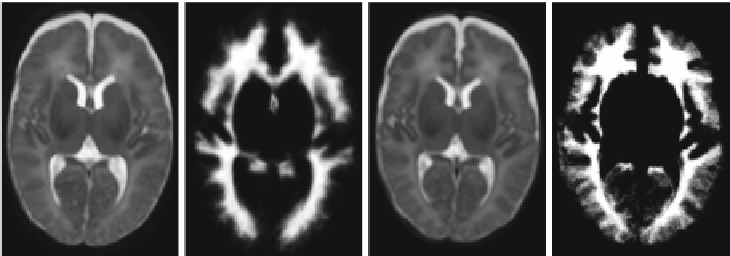Image Processing Reference
In-Depth Information
It should now be observed that the yet stationary velocity fields
g
(
t
k
,t
k
+1
),
which generate the diffeomorphic maps between consecutive time points, can be
interpolated also in the time domain. The resulting time-varying spatio-temporal
velocity field is continuous and therefore denoted here by
g
(
x
,t
). This deforma-
tion model enables the computation of point trajectories
x
(
t
2
)=
x
1
+
t
2
t
1
g
(
x
(
t
)
,t
)
dt
(16)
for any given initial atlas coordinate (
x
1
,t
1
). The error arising from the concate-
nation and temporal interpolation of piecewise-stationary velocity fields decreases
with increasing temporal resolution of the previously constructed atlas.
3
Results
3.1
Subjects
We used T2-weighted (T2-w) fast-spin echo images of 118 neonates acquired on a
3T Philips Intera system with MR sequence parameters TR=1712 ms, TE=160
ms, flip angle 90
ⓦ
and voxel size 0
.
86
1mm
3
. These images were randomly
selected from 445 subjects, with at most 10 subjects from each week gestational
age (GA) to reduce the number of pairs to register. This selection resulted in
a close to uniform age at scan distribution. The age range at time of scan was
27.14 to 49.86 weeks GA, with mean and standard deviation of 36.40
×
0
.
86
×
±
5.70 weeks
GA. The average age at birth was 29.14
3.22, range 24.29-39.71 weeks GA. Out
of 118 subjects, 66 were female, and 52 male.
±
(a)
(b)
(c)
(d)
Fig. 2.
Comparison of T2-w templates and white matter maps at 42 weeks GA. The
images were created in [
18
] using the arithmetic mean of FFDs (a)(b) and by our
method using the Log-Euclidean mean of diffeomorphisms (c)(d).

Search WWH ::

Custom Search